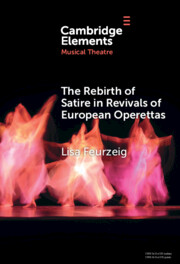Element contents
The Rebirth of Satire in Revivals of European Operettas
Published online by Cambridge University Press: 20 May 2025
Summary
Information
- Type
- Element
- Information
- Series: Elements in Musical TheatreOnline ISBN: 9781009373340Publisher: Cambridge University PressPrint publication: 19 June 2025
